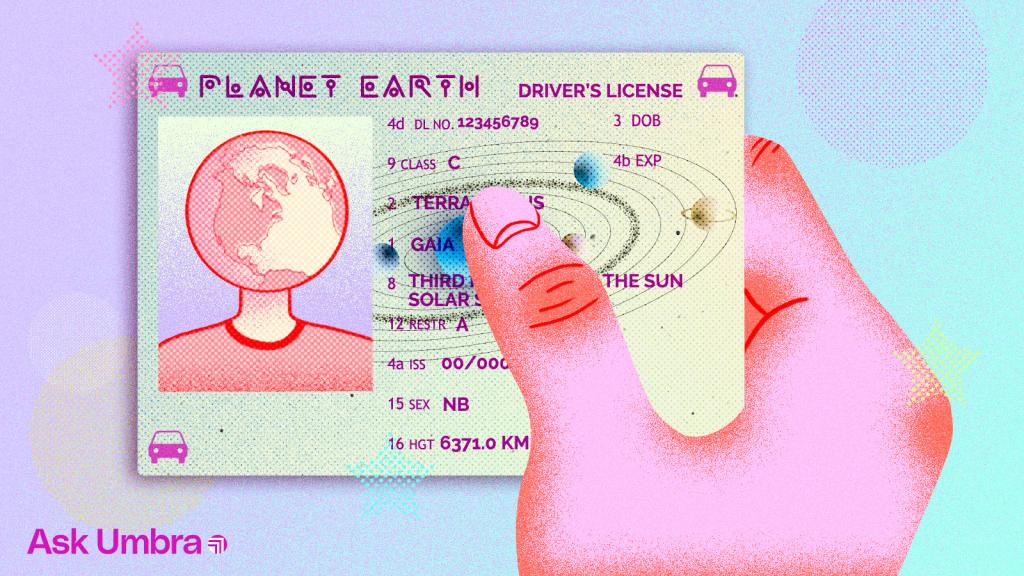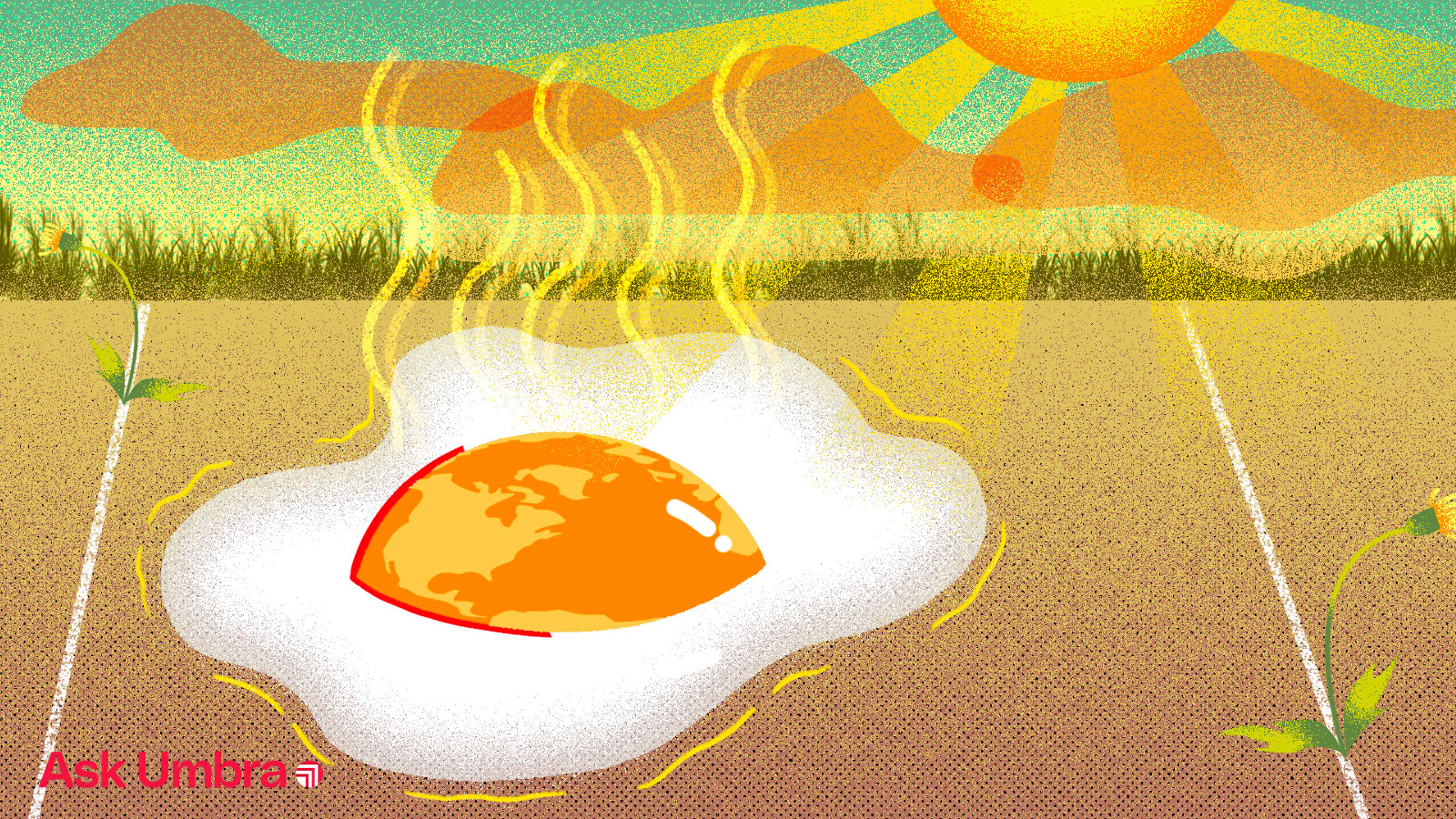Dear Umbra,
It is yet again a billion degrees outside this summer and I don’t know how to reconcile the fact that the fossil-fueled electricity used to power my air conditioner is contributing to these extreme heat waves. And now, to top it all off, we’re also being told in my city to conserve energy because the grid is under too much stress! I’m at a loss for how to keep my cool.
— Hanging Out, Torridly
Dear HOT,
You are living out one of the most acute conundrums of climate change: What do you do when the thing you need to survive warmer temperatures adds to the emissions crisis that creates said warmer temperatures? (The Department of Energy estimates that home air conditioning uses about 6 percent of the total electricity produced in the U.S.) Life in the 21st century is full of impossible choices!
But not all climate Catch-22s are associated with the same guilt level, HOT, and before you get all bothered about cranking up the air conditioner, let’s remember that heat itself is not a new weather phenomenon. Humans have been working on ways to survive a sweltering summer day for millennia. What is new is the scope and intensity of that heat. This June was the hottest on record in North America and the fourth hottest globally. Not only that, when normally temperate geographic regions — such as the Pacific Northwest, most recently — find themselves at 100+ degrees Fahrenheit without the proper infrastructure to deal with it, the situation can become fatal. Last week, at least 95 people in Oregon alone died from heat-related causes.
Would you tell someone at risk of heat stroke not to turn on the air conditioner because it would contribute to global warming? I don’t think so. Relief from high temperatures can be truly life-saving, which is why cities set up public cooling centers; they are not a luxury. Even though about 90 percent of U.S. homes are air-conditioned — by either a central system or window unit — the percentage of low-income households that have no air conditioning is roughly twice that of high-income households.
But when the heat is uncomfortable but not necessarily life-threatening, there are lower-tech, less grid-impacting ways to cool down than air conditioning. (The Centers for Disease Control and Prevention has a very helpful fact sheet on the different signs of heat- and sun-related illness in case you’re unclear on when to seek out the big blowers.) I went back through the Umbra archives and collected the old girl’s tips on sweet heat relief, because as it turns out she’s been advising on this topic for years and years.
Use windows to greater effect
A lot of the heavy lifting of cooling a home can be achieved through simple physics — i.e., window treatments and fan placement:
Quite a bit of the heat in your home — in some cases up to 40 percent — comes through your windows. Your situation may improve if you block light and air from entering your apartment during the hot parts of the day. If you don’t have window shades, off to Windows R Us with you. Shutters or window awnings are the best because they stop sun before it hits window glass, but even thick reflective interior shades will help. If mornings are cool and afternoons are hot, open the windows and shades in the morning and shut them before the unbearable afternoon sun. If the entire day is hot, humid, and miserable, keep everything shut until evening comes. You get the point.
You may further leverage nature if you have a layout (and weather) that permits a cross breeze. Open the incoming breeze window a little, and the outgoing window a lot. On the out window place an out-facing window fan, which will pull the air through the house. Even if you have only two windows, facing the same direction, you may get relief by opening both, placing an inward fan on one and an outward on the other. The feeling of air across your skin can make you feel comfortable even if the air itself is hot. Our standard summer comfort range is 72 to 78 degrees Fahrenheit, but we’ll be comfy at 82 degrees with the help of a light breeze. Don’t say I didn’t give you hard numbers.
Become a fan of fans
Even a small battalion of fans is generally more energy-efficient than an energy-conserving air conditioning unit — and all electrically powered cooling devices should be turned off when not in use!
If the fans are keeping you cool enough, stay with the status quo, because they are either equal to or better than a high-efficiency room air conditioner. Air conditioners also may contain environmentally damaging refrigerants, and while these should not be difficult to contain and properly dispose of, it still would be better to avoid using them. If your current fans are not doing the job, consider installing (or asking your landlord to install) a ceiling fan, which uses even less power than a floor fan and can help the whole room feel cooler. Still not cool enough? If you need to purchase a window air conditioner, please size it correctly for your home and buy the most efficient unit you can afford.
Either way, don’t forget that neither fans nor air conditioning should be operating when you are not at home. Fans make us feel cooler by convecting hot air away from our bods. If our bods are not there, the fan’s energy is wasted. And though we may think leaving AC on all day is more energy-efficient than having it kick into action after we get home, it is not. I repeat: leaving the air conditioning on all day is not energy-efficient. If you can’t stand coming home to a hot house, get a timer for the AC and set it for half an hour before homecoming.
Build your own swamp cooler
And then there is the innovation of something called the “swamp cooler,” which my colleagues Katie Herzog and Jesse Nichols constructed in this classic Grist do-it-yourself video. You basically insulate a fan inside a bucket and it blows cold air at you. I’m not a scientist but it works somehow!
But I do need to emphasize — as always! — that all of these methods for cooling off are proverbial Band-Aids when it comes to the very real and deadly threat of a hotter world. Vivek Shandas, director of sustaining urban places research at Portland State University, said in an email that major social and infrastructure policy overhaul is needed to create a more heat-resilient society.
“Social policies include those that ensure effective communications and engagement systems — generally necessary for all natural disasters — that allow communities to know, by neighborhoods, what resources are available to safeguard from extreme heat,” he wrote. “Engagement systems would create ‘heat ambassadors’ that would be from the community and be remunerated to go door-to-door before a heat wave, and provide information, materials, and other support for individual households — particularly in apartment buildings which face some of the greatest threats from heat — for taking necessary precautions.”
Shandas also wrote that, absent such a formal system, a very effective way to prevent deaths and illnesses during a heat wave is to check on your neighbors. “While we all tend to shelter, and sometimes even avoid our neighbors, heat waves offer an ideal reason for getting to know each other,” he said. Indeed, community bonds have been proven to be one of the strongest indicators of surviving a natural disaster.
On the infrastructure side, we will need insulated buildings that are designed to stay relatively cool without the use of electricity, an electric grid that neither contributes to global warming nor becomes overwhelmed by a lot of people using it simply to survive, and more well-shaded city streets that can mitigate the urban heat island effect. And we will need to ensure that people of color, low-income people, and people without housing also have access to all of that infrastructure so they do not continue to face the worst of extreme heat’s consequences.
Neighborhoods affected by redlining — the systematic refusal of loans and mortages so as to segregate non-white families — are as much as 10 degrees hotter than others, a reality becomes particularly dangerous under heat wave conditions. Jocelyn del Real, empower program coordinator with the Los Angeles organization East Yard Communities for Environmental Justice, said in an email that affordable housing policies and renters’ rights are a crucial part of extreme heat resilience, because we need to “make sure community members are able to stay in their homes year-round and not put at risk of displacement. We are still in a pandemic, so this is crucial.”
Anyway, all that to say, please try to stay cool, my friend, and do not put yourself in peril to save a day’s worth of air-conditioner emissions!. Heat has been proven to not only be deadly, but infuriating. And when the mercury dips to only slightly uncomfortable, feel free to try some energy-friendly alternatives. I personally swear by quick, cold showers and a lot of ice water.
Warmly,
Umbra



